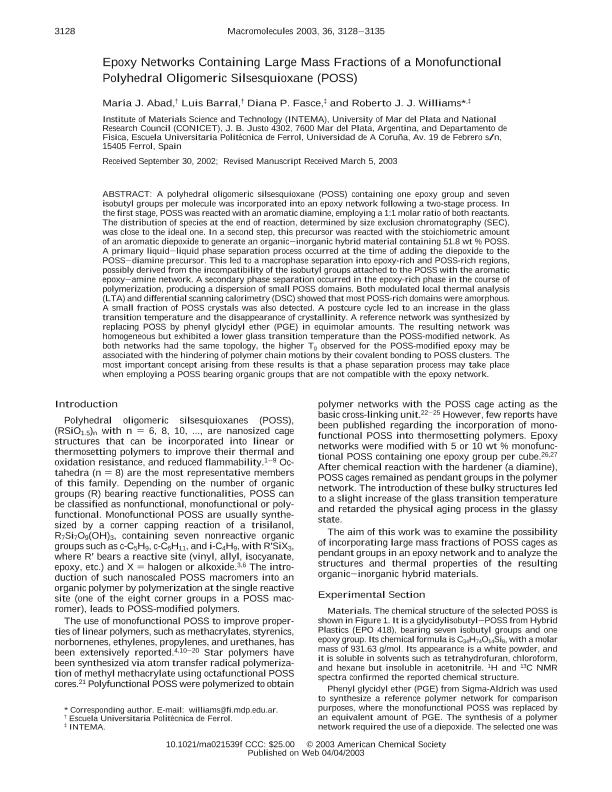Mostrar el registro sencillo del ítem
dc.contributor.author
Abad, María J.
dc.contributor.author
Barral, Luis
dc.contributor.author
Fasce, Diana Patricia

dc.contributor.author
Williams, Roberto Juan Jose

dc.date.available
2019-05-23T23:05:03Z
dc.date.issued
2003-05
dc.identifier.citation
Abad, María J.; Barral, Luis; Fasce, Diana Patricia; Williams, Roberto Juan Jose; Epoxy networks containing large mass fractions of a monofunctional Polyhedral Oligomeric Silsesquioxane (POSS); American Chemical Society; Macromolecules; 36; 9; 5-2003; 3128-3135
dc.identifier.issn
0024-9297
dc.identifier.uri
http://hdl.handle.net/11336/77012
dc.description.abstract
A polyhedral oligomeric silsesquioxane (POSS) containing one epoxy group and seven isobutyl groups per molecule was incorporated into an epoxy network following a two-stage process. In the first stage, POSS was reacted with an aromatic diamine, employing a 1:1 molar ratio of both reactants. The distribution of species at the end of reaction, determined by size exclusion chromatography (SEC), was close to the ideal one. In a second step, this precursor was reacted with the stoichiometric amount of an aromatic diepoxide to generate an organic-inorganic hybrid material containing 51.8 wt% POSS. A primary liquid-liquid phase separation process occurred at the time of adding the diepoxide to the POSS-diamine precursor. This led to a macrophase separation into epoxy-rich and POSS-rich regions, possibly derived from the incompatibility of the isobutyl groups attached to the POSS with the aromatic epoxy-amine network. A secondary phase separation occurred in the epoxy-rich phase in the course of polymerization, producing a dispersion of small POSS domains. Both modulated local thermal analysis (LTA) and differential scanning calorimetry (DSC) showed that most POSS-rich domains were amorphous. A small fraction of POSS crystals was also detected. A postcure cycle led to an increase in the glass transition temperature and the disappearance of crystallinity. A reference network was synthesized by replacing POSS by phenyl glycidyl ether (PGE) in equimolar amounts. The resulting network was homogeneous but exhibited a lower glass transition temperature than the POSS-modified network. As both networks had the same topology, the higher Tg observed for the POSS-modified epoxy may be associated with the hindering of polymer chain motions by their covalent bonding to POSS clusters. The most important concept arising from these results is that a phase separation process may take place when employing a POSS bearing organic groups that are not compatible with the epoxy network.
dc.format
application/pdf
dc.language.iso
eng
dc.publisher
American Chemical Society

dc.rights
info:eu-repo/semantics/openAccess
dc.rights.uri
https://creativecommons.org/licenses/by-nc-sa/2.5/ar/
dc.subject
Polyhedral Oligomeric Silsesquioxane
dc.subject
Epoxy Network
dc.subject.classification
Otras Ciencias Químicas

dc.subject.classification
Ciencias Químicas

dc.subject.classification
CIENCIAS NATURALES Y EXACTAS

dc.title
Epoxy networks containing large mass fractions of a monofunctional Polyhedral Oligomeric Silsesquioxane (POSS)
dc.type
info:eu-repo/semantics/article
dc.type
info:ar-repo/semantics/artículo
dc.type
info:eu-repo/semantics/publishedVersion
dc.date.updated
2019-05-15T16:44:35Z
dc.journal.volume
36
dc.journal.number
9
dc.journal.pagination
3128-3135
dc.journal.pais
Estados Unidos

dc.description.fil
Fil: Abad, María J.. Universidad da Coruña; España
dc.description.fil
Fil: Barral, Luis. Universidad da Coruña; España
dc.description.fil
Fil: Fasce, Diana Patricia. Consejo Nacional de Investigaciones Científicas y Técnicas. Centro Científico Tecnológico Conicet - Mar del Plata. Instituto de Investigaciones en Ciencia y Tecnología de Materiales. Universidad Nacional de Mar del Plata. Facultad de Ingeniería. Instituto de Investigaciones en Ciencia y Tecnología de Materiales; Argentina
dc.description.fil
Fil: Williams, Roberto Juan Jose. Consejo Nacional de Investigaciones Científicas y Técnicas. Centro Científico Tecnológico Conicet - Mar del Plata. Instituto de Investigaciones en Ciencia y Tecnología de Materiales. Universidad Nacional de Mar del Plata. Facultad de Ingeniería. Instituto de Investigaciones en Ciencia y Tecnología de Materiales; Argentina
dc.journal.title
Macromolecules

dc.relation.alternativeid
info:eu-repo/semantics/altIdentifier/doi/http://dx.doi.org/10.1021/ma021539f
dc.relation.alternativeid
info:eu-repo/semantics/altIdentifier/url/https://pubs.acs.org/doi/10.1021/ma021539f
Archivos asociados
